Special Report
These Are The Best Suburbs To Live In Your State
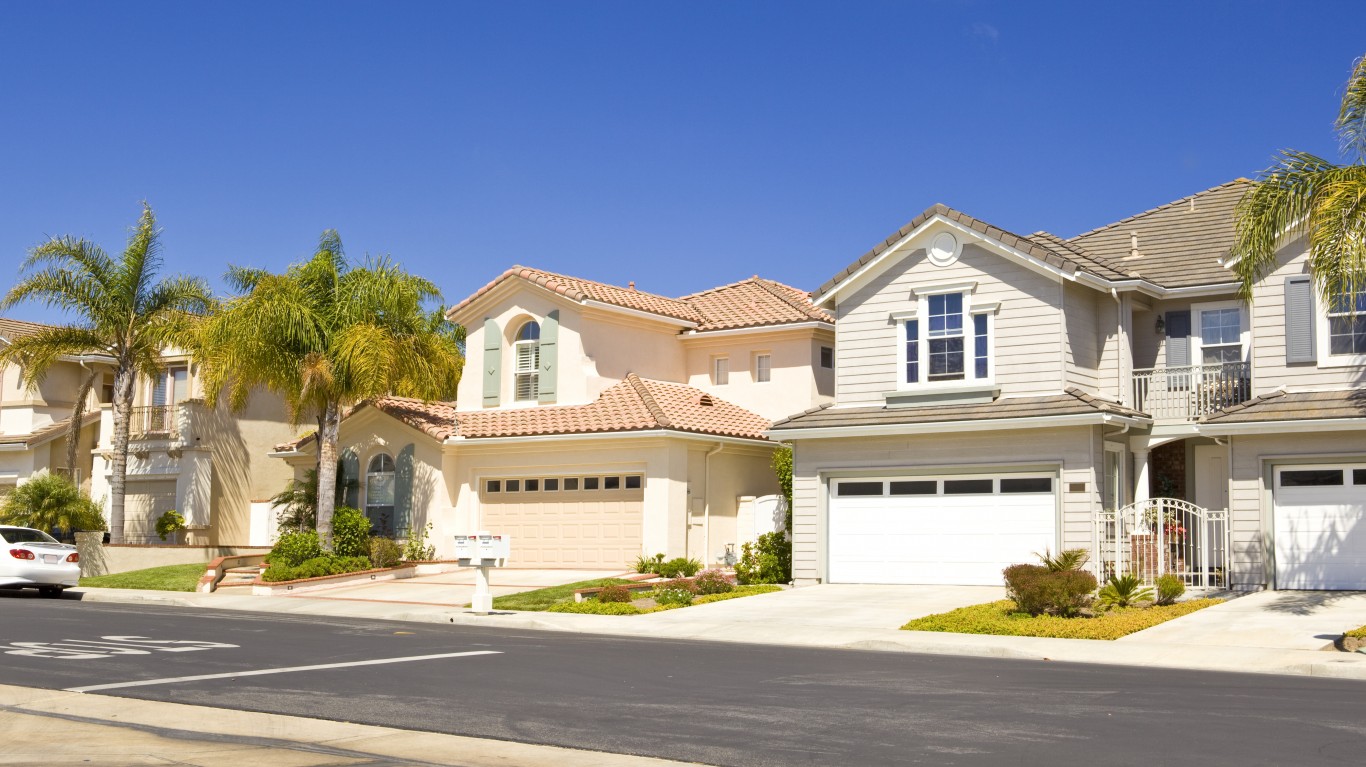
Published:

Suburbs — loosely defined as residential areas in close proximity to a larger city — have been a bastion of the American middle class for over half a century. Suburban communities offer many of the perks of urban living, such as access to jobs, culture, and entertainment, without many of the drawbacks like crime and small living spaces.
Interest in suburban living appears to have surged during the COVID-19 pandemic. Private suburban homes and yards provide families with more living space as they stay home during the pandemic. These are the places in every state where COVID-19 is growing the fastest right now.
24/7 Wall St. created a weighted index of 11 measures — including commute time, home size, crime rates, and affordability — to identify the best suburb in every state. Suburbs were ranked higher in this index if they performed especially well in these measures in comparison to the closest major city.
Many of the qualities Americans likely look for in an ideal suburb — like a strong economy and safe streets — are the same qualities that make any community, urban or rural, attractive. Partially as a result, many of the neighborhoods on this list also rank among the best places to live in the United States in general. Here is a look at America’s 50 best cities to live in.
Click here to see the best suburbs to live in every state.
Click here to read our detailed methodology.
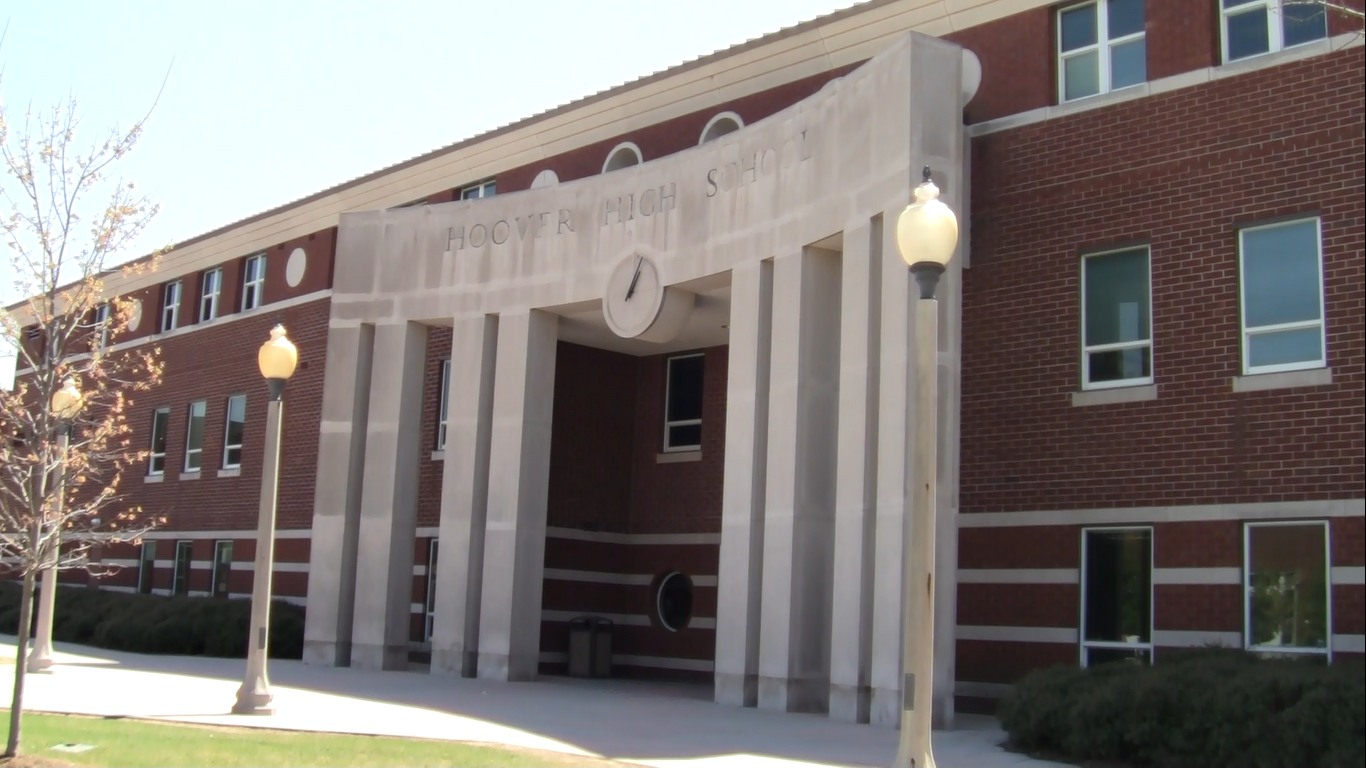
Alabama: Hoover
> Population: 84,480
> Median household income: $84,042
> Homeownership rate: 69.1%
> Avg. commute time: 23.9 minutes
> Metropolitan area: Birmingham
Hoover, a city of about 85,000 people located just south of Birmingham, ranks as the best suburb in Alabama. Real estate values can be indicative of an area’s desirability as a place to live and in Hoover, the typical home is worth $280,400, more than three times the median home value of $89,200 in Birmingham.
Americans often move out to the suburbs in order to own a larger home more suitable for raising a family. In Hoover, the typical house has 6.6 rooms — well above average of 5.2 rooms in Birmingham and 5.5 rooms across the U.S. as a whole.
[in-text-ad]

Alaska: Palmer
> Population: 6,978
> Median household income: $60,350
> Homeownership rate: 62.0%
> Avg. commute time: 29.7 minutes
> Metropolitan area: Anchorage
Palmer is a small city of about 7,000 located less than 50 miles northwest of downtown Anchorage. Though it is quite far from its core city, it is within the metropolitan area’s boundaries. One reason many Americans choose to relocate to the suburbs is because they often have lower crime rates and safer streets — and Palmer is no exception. The local violent crime rate of 280 incidents for every 100,000 residents is a small fraction of the violent crime rate of 1,245 incidents per 100,000 in Anchorage.

Arizona: Paradise Valley
> Population: 14,215
> Median household income: $204,145
> Homeownership rate: 93.5%
> Avg. commute time: 22.4 minutes
> Metropolitan area: Phoenix
Paradise Valley, an affluent community just north of Scottsdale, ranks as the best suburb in Arizona. Developed after World War II and incorporated in 1961 to protect against sprawl from nearby Phoenix. According to the town’s website, Paradise Valley strives to maintain its identity as a quiet residential community.
Homes in Paradise Valley tend to be large and expensive. Most have over nine rooms and cost more than $1.5 million. A relatively safe area, the violent crime rate in Paradise Valley is less than a 10th of the violent crime rate in Phoenix.

Arkansas: Cave Springs
> Population: 3,881
> Median household income: $114,286
> Homeownership rate: 93.6%
> Avg. commute time: 18.8 minutes
> Metropolitan area: Fayetteville
Cave Springs, Arkansas, located about 15 miles north of downtown Fayetteville ranks as the best suburb in the state. Though local residents are not living within the limits of a large city, their close proximity to Fayetteville provides easy access to a relatively large job market. Only 1.4% of the Cave Springs labor force are unemployed and the average commute time is just under 19 minutes — well below the national unemployment rate of 5.9% and average commute time of 26.6 minutes.
Like other suburbs on this list, Cave Springs is a safe community. There were only 54 violent crimes reported in the city for every 100,000 people in 2019, a small fraction of the violent crime rate of 447 per 100,000 in Fayetteville.
[in-text-ad-2]
California: Atherton
> Population: 7,185
> Median household income: $250,000+
> Homeownership rate: 93.6%
> Avg. commute time: 23 minutes
> Metropolitan area: San Francisco
Atherton is a small affluent community located about 30 miles south of San Francisco. The town, which covers 6 square miles boasts a 22-acre park filled with trees, gardens, playgrounds, tennis courts, and walking paths. With roots as far back as the 1860s when it was a stop along the Southern Pacific Railroad and incorporated in 1923, Atherton has a long history. Still, over 15% of local homes have been built in the last 20 years.
Though it ranks as the best suburb in California — even when accounting for affordability — Atherton real estate is prohibitively expensive for most Americans. The typical area home is worth over $2 million. Not surprisingly, most Atherton households report annual incomes that exceed a quarter million dollars.
Colorado: Cherry Hills Village
> Population: 6,600
> Median household income: $250,000+
> Homeownership rate: 95.2%
> Avg. commute time: 19.7 minutes
> Metropolitan area: Denver
The affluent Denver suburb of Cherry Hills ranks as the best suburb in Colorado. A safe community, Cherry Hills Village’s violent crime rate of 45 incidents for every 100,000 people is a small fraction of the comparable rate of 749 per 100,000 people in Denver, located less than 10 miles away.
Though not living in a heavily populated city, Cherry Hill residents still have relatively short commute times. The typical worker in the city spends about 20 minutes getting to work, about six and a half minutes below the national average.
[in-text-ad]
Connecticut: Darien
> Population: 21,759
> Median household income: $210,511
> Homeownership rate: 85.3%
> Avg. commute time: 36.4 minutes
> Metropolitan area: Bridgeport
Life in the small community of Darien, Connecticut, offers a sharp juxtaposition from life in the nearby city of Bridgeport. Just 5.2% if the labor force in Darien are unemployed, less than half the 13.4% unemployment rate in Bridgeport. Additionally, just 3.1% of the Darien population lives below the poverty line, compared to 21.4% of the Bridgeport population. Perhaps most striking is the difference in crime rate. Darien reported only 14 violent crimes for every 100,000 people in 2019, while Bridgeport reported 582 violent crimes per 100,000 people the same year.
As is often the case, living in the top ranking suburb in Connecticut is not cheap. The typical home in the area is worth about $1.5 million and most local households have annual incomes in excess of $210,000.
Delaware: Middletown
> Population: 21,250
> Median household income: $89,354
> Homeownership rate: 79.4%
> Avg. commute time: 36.9 minutes
> Metropolitan area: Philadelphia
Middletown, located on the Delmarva Peninsula about 60 miles southwest of Philadelphia, ranks as the best suburb in Delaware. The community is relatively safe and offers nearly all residents easy access to places like parks and recreation centers.
The area has grown rapidly in recent years. Now home to more than 21,000 people, the local population was less than 4,000 as recently as the early 1990s. As a result, most homes are new construction — with nearly 70% of them built since 2000. Homes also tend to be relatively large in the area, offering more than one more room on average than the typical American home. And although the typical area home is worth $288,400 — at least $80,000 more than most U.S. homes — homes are relatively affordable when considering area incomes.

Florida: Parkland
> Population: 30,471
> Median household income: $146,094
> Homeownership rate: 84.2%
> Avg. commute time: 29.9 minutes
> Metropolitan area: Miami
Parkland, located about 50 miles north of Miami, offers many advantages Americans look for in a suburb, including larger homes better suited to raising a family. The average home in Parkland has about seven and a half rooms, compared to an average of fewer than four rooms in Miami.
Although the area is home to Stoneman Douglas High School, where a tragic 2018 school shooting left 17 dead, Parkland is otherwise a safe community. There were only about 26 violent crimes in Parkland for every 100,000 people in 2019, a fraction Miami’s violent crime rate of 593 incidents per 100,000 people.
[in-text-ad-2]
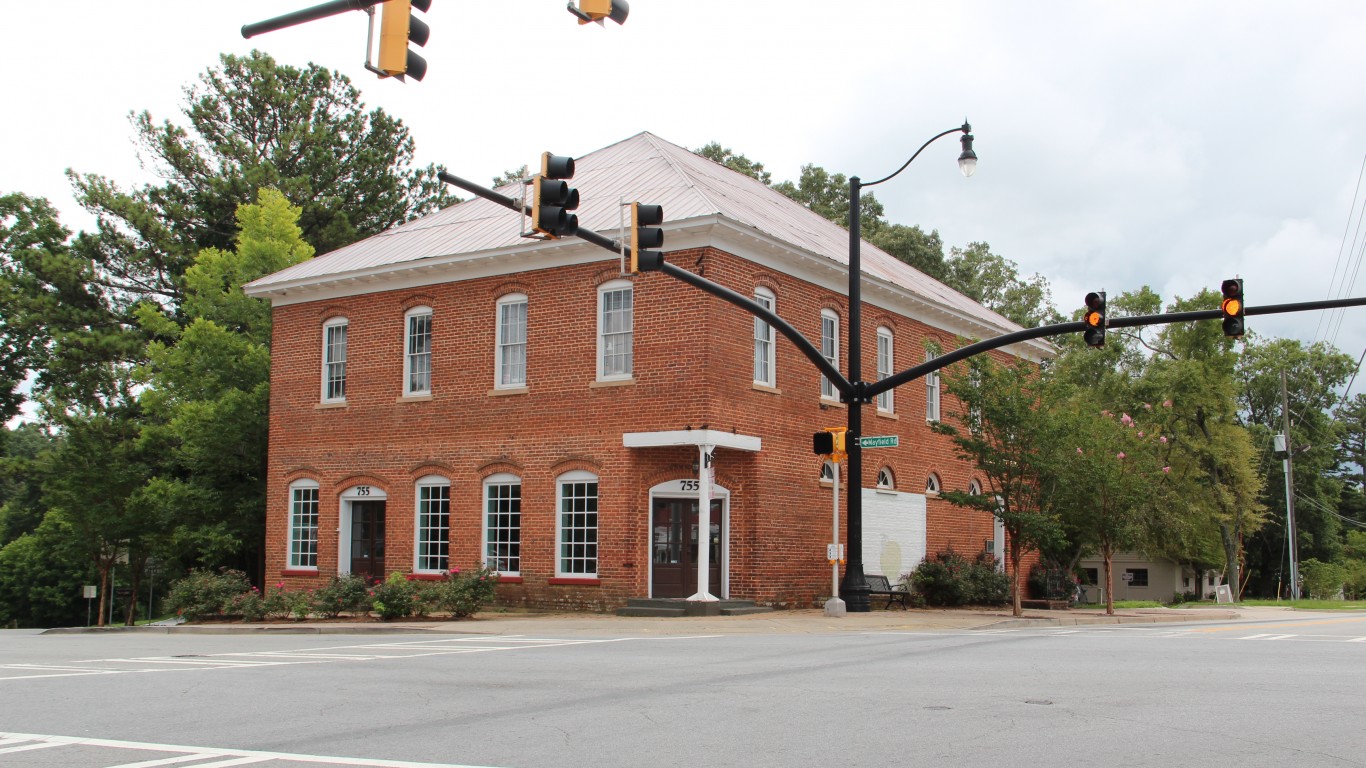
Georgia: Milton
> Population: 38,171
> Median household income: $125,096
> Homeownership rate: 73.3%
> Avg. commute time: 28.7 minutes
> Metropolitan area: Atlanta
Milton, an Atlanta suburb that spans about 23,000 acres, was incorporated in 2006. The best suburb in Georgia, Milton is a very safe city with one of the lowest violent crime rates in the country. Well geared toward families, the typical house in Milton has eight rooms, compared to fewer than five in Atlanta. Area residents also have access to a healthy job market, as just 3.1% of the labor force is out of work.
Like most communities on this list, Milton is relatively affluent. The typical area household earns about $125,000 a year.

Hawaii: Maunawili
> Population: 2,023
> Median household income: $135,000
> Homeownership rate: 90.9%
> Avg. commute time: 28.6 minutes
> Metropolitan area: Urban Honolulu
Maunawili, a small unincorporated town outside of Honolulu, ranks as the best suburb in Hawaii. They benefit from a strong job market as only 2.2% of members of the labor force are unemployed, compared to the national 5.9% unemployment rate.
Like many suburbs on this list, Maunawili has a relatively affluent and well-educated population. Nearly 99% of the city’s adult residents have a high school diploma and 62.5% have a bachelor’s degree, well above the 87.7% and 31.5% respective national shares. Additionally, the typical area household earns $135,000 annually, far more than the $60,293 national median income.
[in-text-ad]

Idaho: Meridian
> Population: 97,008
> Median household income: $68,131
> Homeownership rate: 76.7%
> Avg. commute time: 22.1 minutes
> Metropolitan area: Boise City
Meridian residents live in a far safer community than their neighbors in the nearby city of Boise. There were only 159 incidents of violent crime in Meridian for every 100,000 people in 2019, about half the violent crime rate in Boise.
The best suburb in Idaho, Meridian is growing rapidly. As recently as 1990, only about 10,000 people lived in Meridian. Now, the area is home to nearly 100,000 people. Rapid population growth has ushered in a boom in residential construction. Over half of all homes in the area were built in the last 20 years. The city recently implemented a multi-year comprehensive plan to accommodate continued growth.
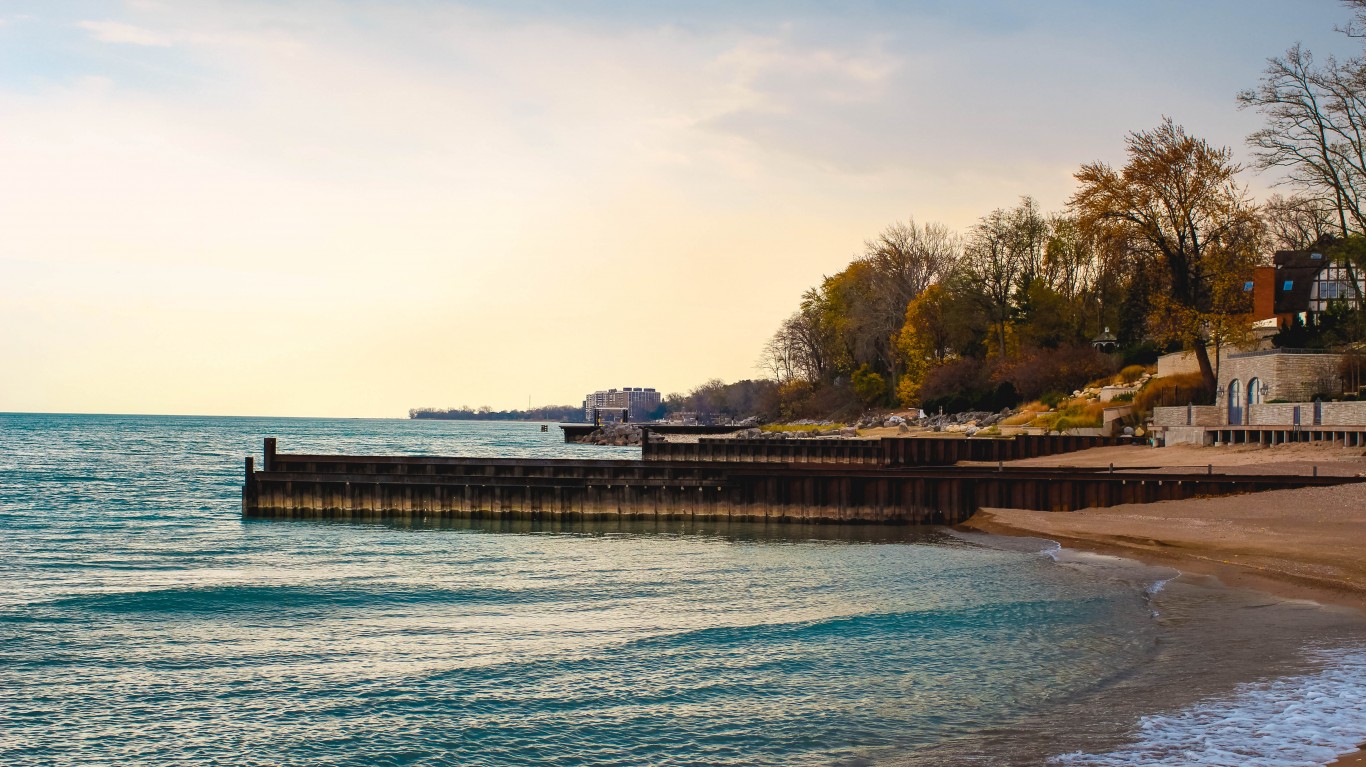
Illinois: Winnetka
> Population: 12,481
> Median household income: $220,577
> Homeownership rate: 89.0%
> Avg. commute time: 36.6 minutes
> Metropolitan area: Chicago
Winnetka is a small village along the shore of Lake Michigan about 20 miles north of downtown Chicago. Winnetka residents have easy access to the largest city in the Midwest with a commuter line that goes directly downtown. As is often the case in communities on this list, unemployment is low in Winnetka. The village’s five-year average unemployment rate of 2.4% is less than half the comparable national figure of 5.9%.
One of the primary reasons many Americans choose to relocate to the suburbs is because of the relative safety they typically offer — and the difference in crime rates between Winnetka and Chicago is stark. There were only eight violent crimes for every 100,000 people in Winnetka in 2019 compared to Chicago’s violent crime rate of 943 incidents per 100,000 people.
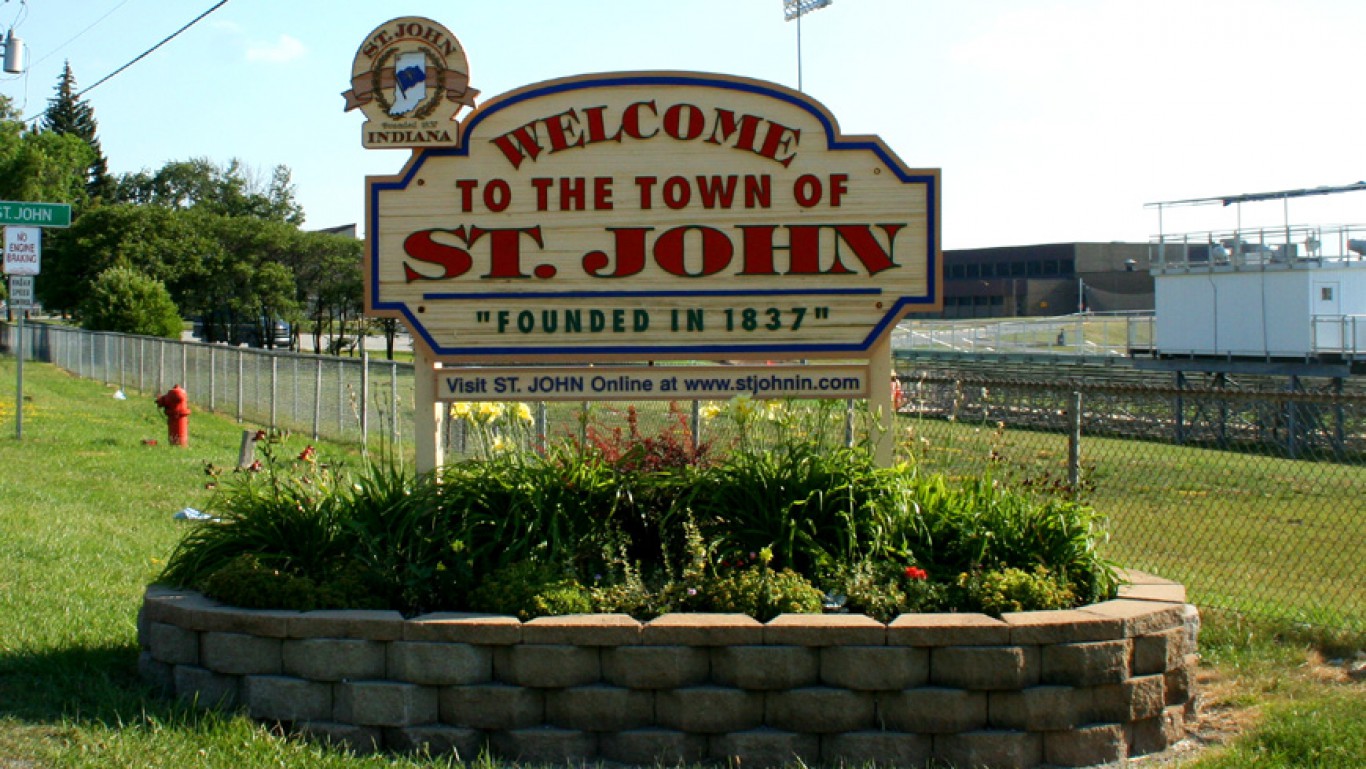
Indiana: St. John
> Population: 16,839
> Median household income: $105,198
> Homeownership rate: 97.5%
> Avg. commute time: 36.9 minutes
> Metropolitan area: Chicago
St. John, Indiana, a small town less than 40 miles south of Chicago, ranks as the best suburb in the state. Homes in the area are generally relatively new, and large. Nearly half of all area homes were built in the last two decades and most have over seven rooms, while the typical U.S. home has fewer than six rooms.
In addition to relatively large homes, which are preferable to those starting a family, the area is also relatively safe, There were only 22 violent crimes for every 100,000 people in St. John in 2019 compared to Chicago’s violent crime rate of 943 incidents per 100,000 people.
[in-text-ad-2]

Iowa: Clive
> Population: 17,195
> Median household income: $101,616
> Homeownership rate: 79.8%
> Avg. commute time: 17.9 minutes
> Metropolitan area: Des Moines
Situated on the western edge of Des Moines, Clive, Iowa offers residents access to a strong job market and short commutes. An average of only 2.7% of members of the local labor force have been unemployed over the last five years, half the comparable national unemployment rate. Additionally, the average commute time in the area is only about 18 minutes, nearly nine minutes below the national average.
The city also offers residents nearly 300 acres of parks, low crime, and relatively affordable homes.

Kansas: Leawood
> Population: 34,570
> Median household income: $149,736
> Homeownership rate: 90.5%
> Avg. commute time: 21.3 minutes
> Metropolitan area: Kansas City
Leawood, Kansas, is a town spanning about 15 square miles located 10 miles southwest of downtown Kansas City, Missouri. Homes in the area tend to be relatively large and about a fifth of them were built within the last 20 years.
Local residents benefit from the jobs available in nearby Kansas City, without having to worry about the problems of a big city, like more violent crime. Only 2.4% of members of the labor force have been unemployed in the last five years, well below the comparable 5.9% national jobless rate. Additionally, there were only 54 violent crimes for every 100,000 people in Leawood in 2019, compared to 1,431 per 100,000 in Kansas City.
[in-text-ad]
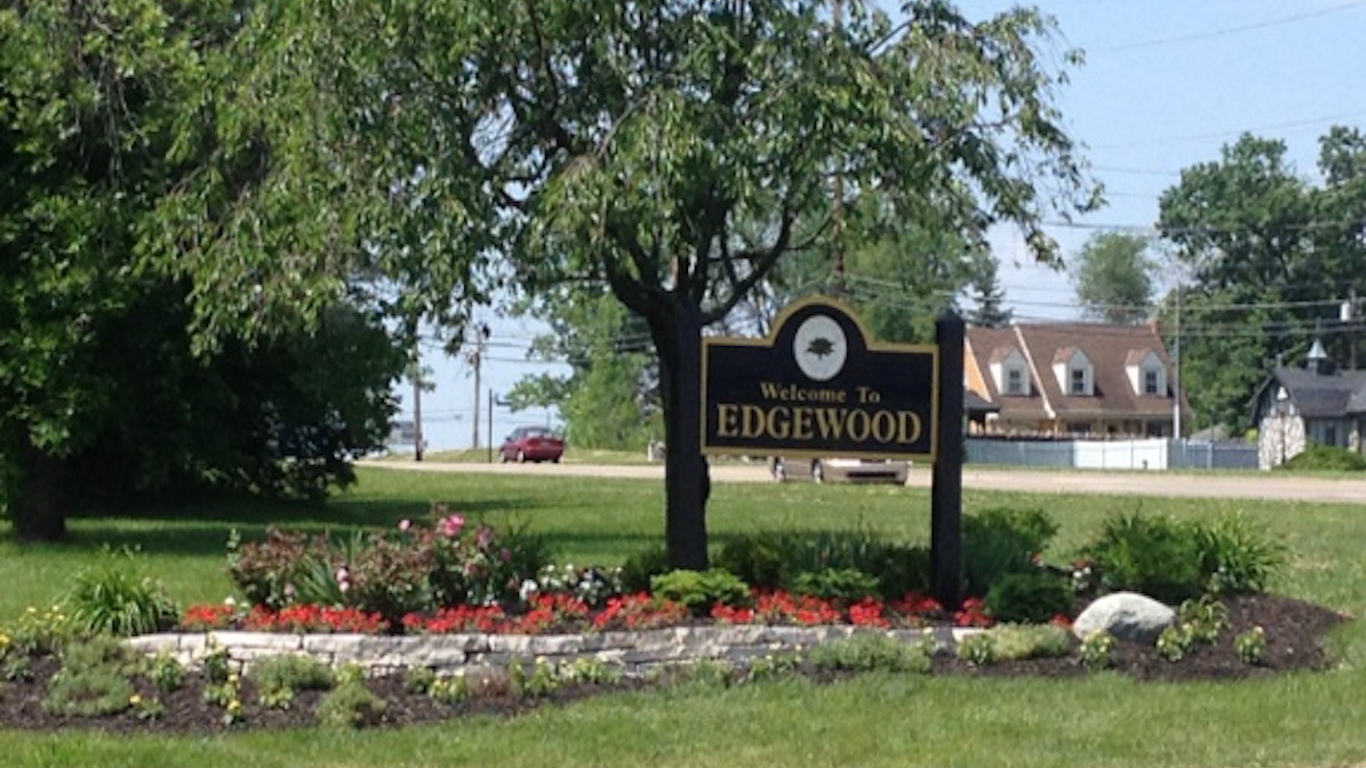
Kentucky: Edgewood
> Population: 8,723
> Median household income: $99,183
> Homeownership rate: 87.4%
> Avg. commute time: 22 minutes
> Metropolitan area: Cincinnati
Edgewood, Kentucky, located less than 10 miles south of Cincinnati and the Ohio border, ranks as the best suburb to live in the state. An affordable community, the typical home is worth $222,300, or only about 2.2 times the area’s median annual household income. Nationwide, the typical home is worth 3.4 times more than the median household income. The area boasts a short average commute time, access to plenty of employment opportunities, and low crime rates.
Edgewood also has a set of guidelines for local residents. The guidelines, which have been in place since 2010, stipulate that weeds, garbage, or rotting wood on homes are not permitted.

Louisiana: Youngsville
> Population: 12,753
> Median household income: $86,637
> Homeownership rate: 85.0%
> Avg. commute time: 30.3 minutes
> Metropolitan area: Lafayette
Youngsville, Louisiana, boasts many advantages other suburbs on this list have, including low unemployment, safe streets, and an abundance of parks. Unlike some other suburbs, however, Youngsville is also relatively affordable. The typical area home is worth $223,600, or only about 2.6 times the nation’s median household income. Meanwhile, the typical U.S. home is worth 3.4 times more than the national median household income.
Youngsville is a historic town that traces its roots back to French Acadian settlers. In recent decades, it has been among the fastest growing communities in the state. Just 30 years ago, there were fewer than 2,300 people living in Youngsville, and today there are nearly 13,000.
Maine: Hampden
> Population: 3,889
> Median household income: $87,750
> Homeownership rate: 84.4%
> Avg. commute time: 17.2 minutes
> Metropolitan area: Bangor
Hampden, Maine, located just south of Bangor, offers residents many of the benefits that proximity to a larger city offers without the drawback associated with living in a city. For example, Hampden residents benefit from the jobs available in nearby Bangor without much of a commute. Just 2.1% of labor force members in Hampden were unemployed in the last five years, less than half the comparable national unemployment rate, and the average commute lasts only about 17 minutes — nearly 10 minutes below the national average.
Hampden is also a better educated community than Bangor. An estimated 46.5% of area adults have a bachelor’s degree or higher, compared to 33.9% of adults in Bangor and 31.5% of adults nationwide.
[in-text-ad-2]
Maryland: Mount Airy
> Population: 9,395
> Median household income: $117,341
> Homeownership rate: 91.6%
> Avg. commute time: 40.5 minutes
> Metropolitan area: Baltimore
Mount Airy, located less than 40 miles west of Baltimore, ranks as the best suburb in Maryland. A wealthy state, Maryland is full of communities that would be prohibitively expensive for most Americans, but Mount Airy is actually more affordable than much of the country. The typical home in the area is worth $368,500 — or 3.1 times the town’s median household income. Nationwide, the typical home is worth 3.4 times the income the typical household earns.
Safe streets and bigger homes are two reasons many Americans relocate to suburbs — and Mount Airy offers both. There were only 53 violent crimes for every 100,000 people in Mount Airy in 2019 compared to 1,859 per 100,000 in Baltimore. Additionally, the typical Mount Airy home has 7.8 rooms, compared to the typical Baltimore home, which has just 5.6 rooms.
Massachusetts: Dover
> Population: 2,533
> Median household income: $212,574
> Homeownership rate: 93.6%
> Avg. commute time: 31.2 minutes
> Metropolitan area: Boston
Dover is a relatively affluent and well-educated community located less than 30 miles southwest of Boston. More than half of all area households earn over $200,000 a year and more than three in every four residents age 25 and up have a bachelor’s degree. Homes in the area are generally large — most having more than nine rooms — and well-suited to those raising families.
In close proximity to Boston and the jobs available there, Dover residents are less likely than most Americans to be out of work. The area’s average five-year unemployment rate is just 2.2%, less than half the comparable 5.9% national rate.
[in-text-ad]

Michigan: Huntington Woods
> Population: 6,340
> Median household income: $130,417
> Homeownership rate: 97.6%
> Avg. commute time: 23.1 minutes
> Metropolitan area: Detroit
The Detroit suburb of Huntington Woods ranks as the best suburb in Michigan — largely because of how it stands in sharp contrast to some of Detroit’s less appealing attributes. For example, there were a reported 1,965 violent crimes committed in Detroit for every 100,000 people in 2019. Meanwhile, about 15 miles away in Huntington Woods, there were none. Huntington Woods residents also tend to be relatively financially secure, as the town’s poverty rate is just 2.2% — compared to 36.4% in Detroit.
Homes in Huntington Woods are also larger and better-suited for families than those in Detroit, with most having at least two more rooms than most homes in Motor City.
Minnesota: Medina
> Population: 6,191
> Median household income: $144,107
> Homeownership rate: 93.8%
> Avg. commute time: 28 minutes
> Metropolitan area: Minneapolis
Medina, Minnesota, is a small city about 20 miles northeast of downtown Minneapolis well suited to families. Medina has relatively large homes and very little crime. The typical house in the city has more than nine rooms, while the typical house in nearby Minneapolis has fewer than five. Additionally, there were only 15 violent crimes for every 100,000 people in Medina in 2019, a fraction of the 926 violent crimes for every 100,000 people in Minneapolis.
First settled by Europeans in the mid-1800s, Medina was not incorporated as a city until 1974. In the last 30 years, Medina’s population has roughly doubled.

Mississippi: Madison
> Population: 25,522
> Median household income: $106,849
> Homeownership rate: 93.2%
> Avg. commute time: 22.4 minutes
> Metropolitan area: Jackson
Madison, Mississippi, is located about 15 miles north of the state capital of Jackson. Madison residents have relatively easy access to jobs in Jackson, and partially as a result, the area’s unemployment rate has averaged just 1.8% over the last five years. Incomes in Madison are relatively high and financial hardship is scarce. Most local households earn over $106,000 a year and only 3.3% of the population lives below the poverty line.
Homes in Madison tend to have more rooms than average and the local violent crime rate is lower than it is in the vast majority of U.S. cities.
[in-text-ad-2]
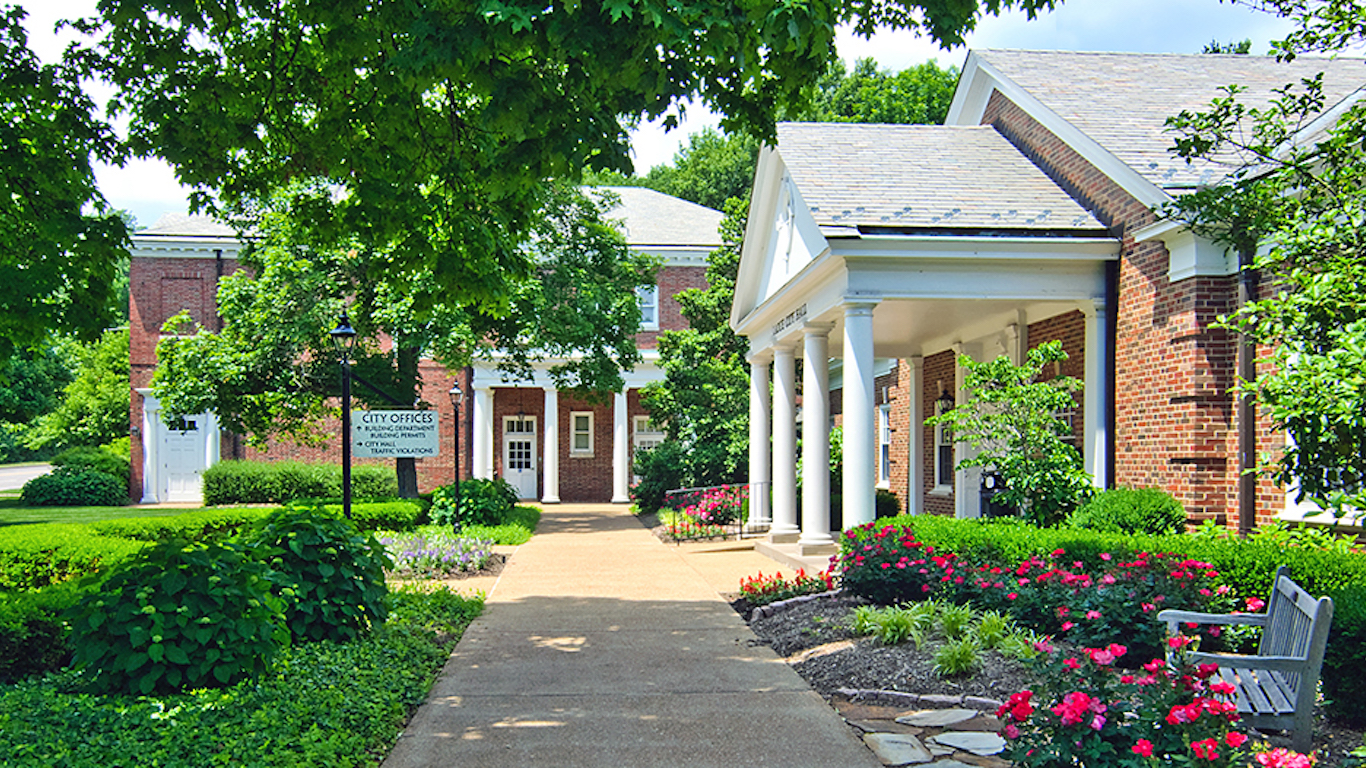
Missouri: Ladue
> Population: 8,586
> Median household income: $192,500
> Homeownership rate: 97.5%
> Avg. commute time: 17.6 minutes
> Metropolitan area: St. Louis
St. Louis is one of the most dangerous cities in the United States. There were 1,927 violent crimes reported in the city for every 100,000 people in 2019, more than five times the national violent crime rate that year. However, in Ladue, a suburb only about 12 miles west of St. Louis, the violent crime rate was just 92 per 100,000.
Ladue is also home to a more financially stable population than St. Louis as only 2.2% of the population lives in poverty, compared to 24.2% of the population in the larger city. Ladue also has relatively large homes — most with more than nine rooms — that are perhaps better suited for growing families than those in St. Louis, most of which have fewer than five rooms.

Montana: Laurel
> Population: 6,849
> Median household income: $50,541
> Homeownership rate: 68.7%
> Avg. commute time: 20.9 minutes
> Metropolitan area: Billings
Laurel, the best suburb to live in in Montana, is located just 13 miles west of Billings, the largest city in the state. Relative to incomes, homes in Laurel are relatively affordable and in close proximity to employment opportunities. In addition to jobs in Billings, large employers in Laurel include Montana Rail Link and the Cenex Harvest States Refinery. The average commute time for workers in Laurel is just 21 minutes, compared to the average of almost 27 minutes nationwide.
[in-text-ad]
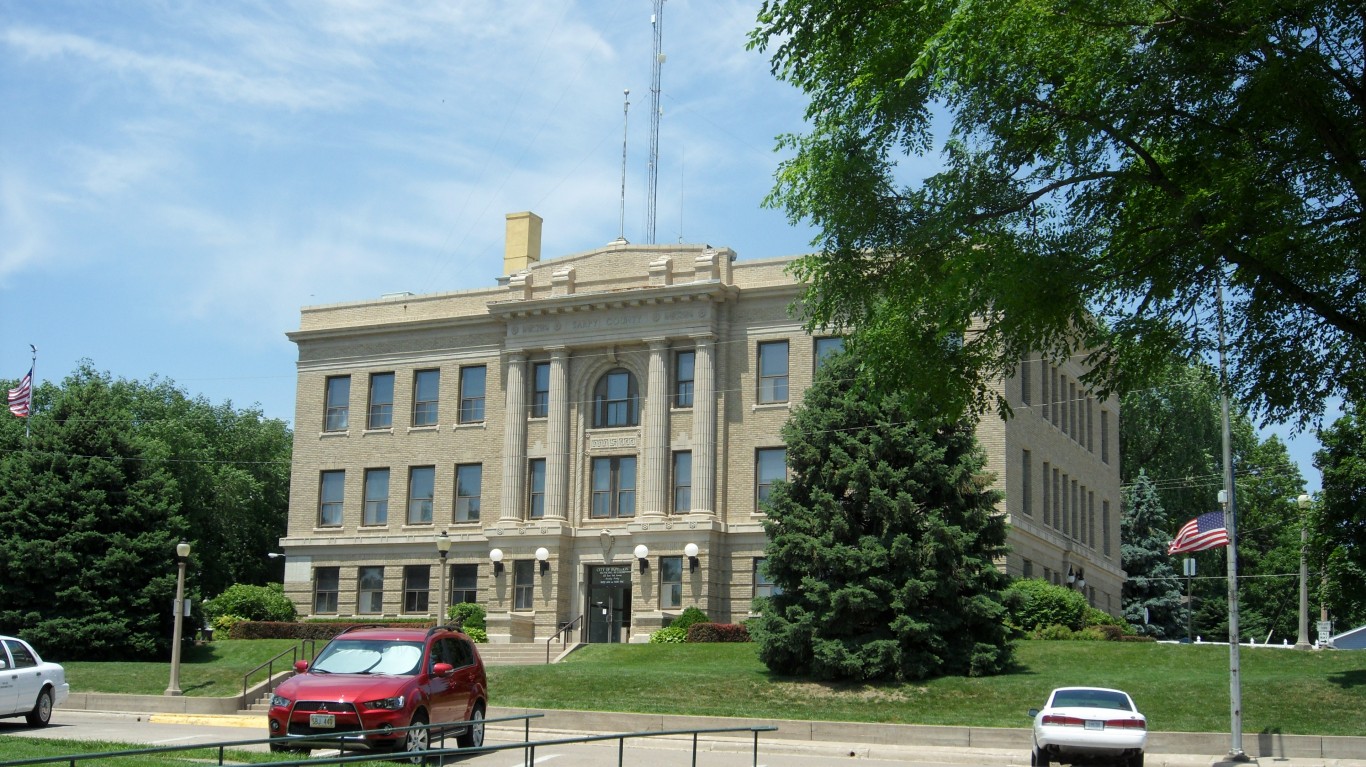
Nebraska: Papillion
> Population: 20,466
> Median household income: $80,853
> Homeownership rate: 67.4%
> Avg. commute time: 19.9 minutes
> Metropolitan area: Omaha
The small city of Papillion, located less than 15 miles southeast of Omaha, ranks as the best suburb in Nebraska. WIth easy access to Omaha, there are plenty of job opportunities for workers in the area. An average of just 2.2% of local labor force members have been unemployed in the last five years, compared to a 5.9% national jobless rate. With a low violent crime rate, Papillon is also far safer than Omaha.
Papillon, founded as a railroad town in 1870, has grown rapidly in recent decades. As recently as 1970, the city was home to fewer than 6,500 residents. Today, it has nearly 20,500 residents.
Nevada: Boulder City
> Population: 15,680
> Median household income: $60,870
> Homeownership rate: 69.2%
> Avg. commute time: 24.3 minutes
> Metropolitan area: Las Vegas
Boulder City, a community located about 25 miles southeast of Las Vegas, ranks as the best suburb in Nevada largely because of the relative safety it affords its residents. There were only 118 violent crimes reported in the city for every 100,000 people in 2019, less than one-quarter the comparable violent crime rate of 531 per 100,000 in Las Vegas.
Boulder City residents are also more likely to be financially stable than those living in Las Vegas. The poverty rate in Boulder City stands at 10.2%, while in Las Vegas, 15.8% of the population lives below the poverty line.
New Hampshire: Goffstown
> Population: 3,000
> Median household income: $83,480
> Homeownership rate: 76.4%
> Avg. commute time: 33 minutes
> Metropolitan area: Manchester
Goffstown, New Hampshire, was originally a farming community when it was incorporated in 1761. Today, the historic town, located across the Merrimack River from Manchester, ranks as the best suburb in the state. Goffstown is a relatively affordable place to live, as the typical area home is worth $225,500, or only about 2.8 times the median household income in the area. Nationwide, the typical home is worth 3.4 times the median income.
Like most desirable suburbs, Goffstown is safe. There were fewer than 100 violent crimes reported in the area for every 100,000 people in 2019, compared to over 600 per 100,000 in Manchester the same year.
[in-text-ad-2]

New Jersey: Rumson
> Population: 6,805
> Median household income: $177,857
> Homeownership rate: 91.9%
> Avg. commute time: 45.2 minutes
> Metropolitan area: New York
Rumson is an affluent coastal community located directly south of Brooklyn, across the Lower and Sandy Hook Bays. Homes in the area are large, with most having more than nine rooms. For reference, the typical U.S. home has fewer than six rooms. A safe community, Rumson is one of a small minority of places nationwide to report no incidents of violent crime in 2019.
With relatively easy access to jobs in New York City, Rumson has a relatively low unemployment rate. An average of only 2.9% of local labor force members were unemployed in the last five years, less than half the comparable 5.9% national jobless rate.

New Mexico: Corrales
> Population: 8,544
> Median household income: $79,303
> Homeownership rate: 89.7%
> Avg. commute time: 25.3 minutes
> Metropolitan area: Albuquerque
Corrales, a small village of about 8,500 located 15 miles north of Albuquerque, is free of much of the socioeconomic problems that the nearby big city faces. For example, just 5.7% of the suburban community’s population lives below the poverty line, compared to 17.6% of people living in Albuquerque. Corrales is also a safe city, with a violent crime rate of 138 incidents per 100,000 people, less than half the comparable national rate of 367 per 100,000.
Before the area that is now Corrales was settled by the Spanish in the mid-1500s, it was occupied for centuries by native American populations. The area is still home to two unexcavated Pueblo villages. Today, the village bills itself as a quieter and more rural alternative to Albuquerque.
[in-text-ad]
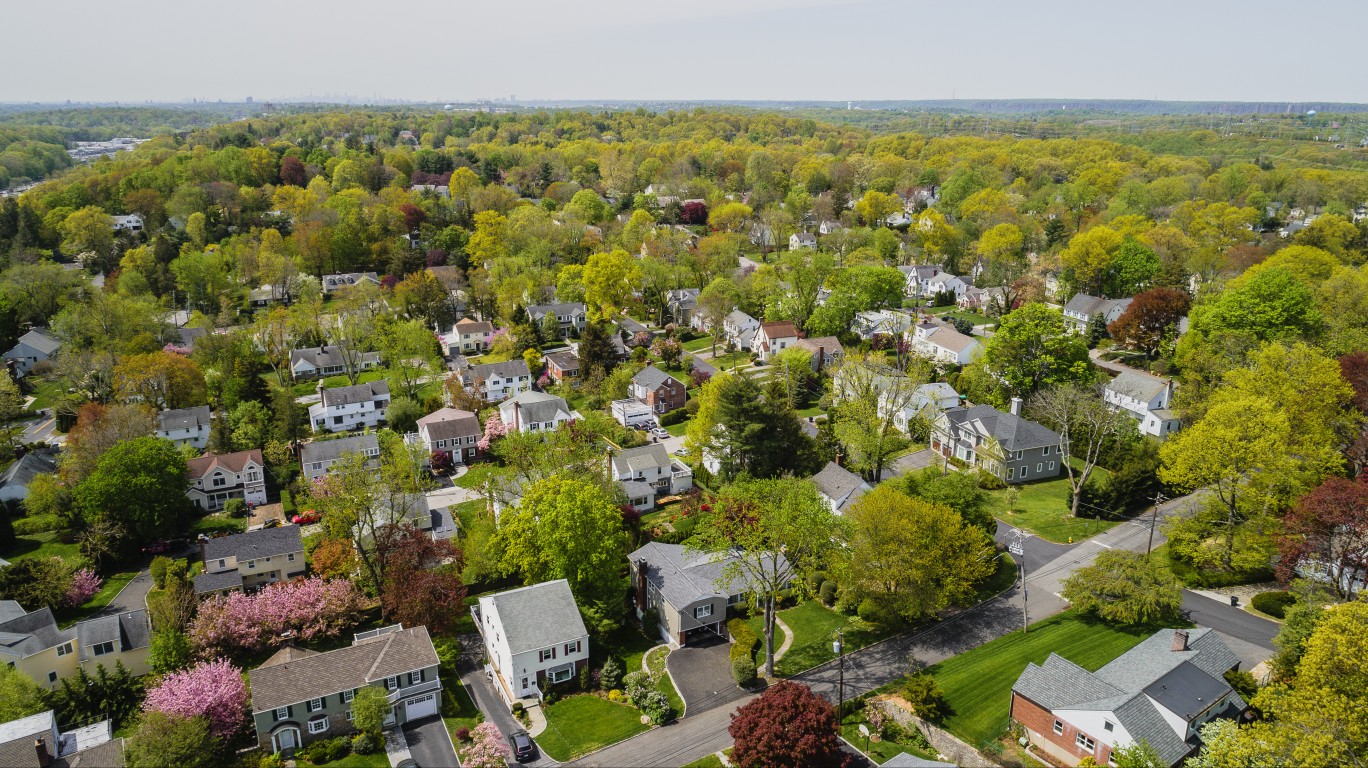
New York: Scarsdale
> Population: 17,805
> Median household income: $250,000+
> Homeownership rate: 90.6%
> Avg. commute time: 42.8 minutes
> Metropolitan area: New York
Scarsdale is a village of nearly 18,000 people less than 20 miles north of Midtown Manhattan. Its residents tend to be much more affluent than those living in New York City. The unemployment rate in Scarsdale of 2.3% is a third of the New York City rate. The typical household earns over a quarter million dollars per year, and most houses in Scarsdale are worth over $1.4 million. The homeownership rate is over 90%, compared to 63.8% nationwide.
Scarsdale also has a much lower violent crime rate — at 33.4 incidents per 100,000 residents — than New York City, which reported 571 violent crimes per 100,000.
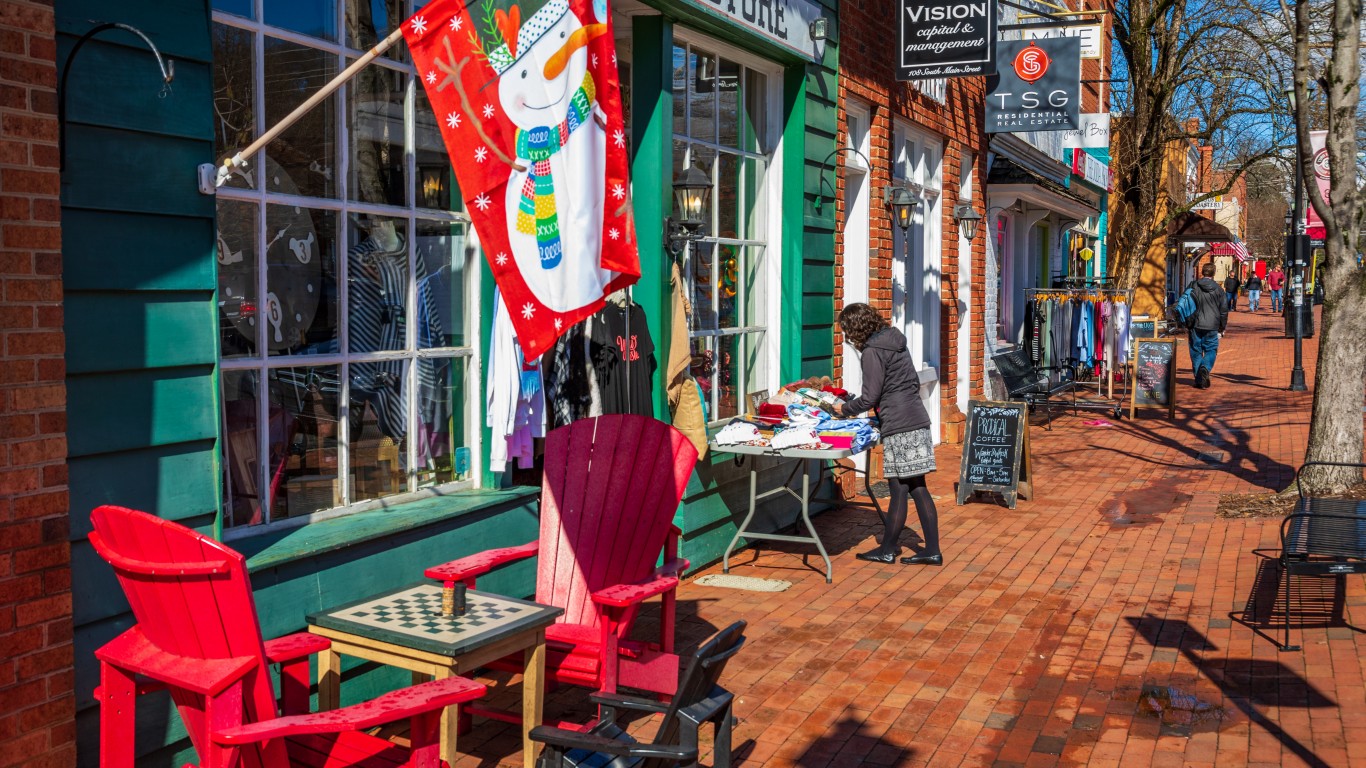
North Carolina: Davidson
> Population: 12,666
> Median household income: $128,255
> Homeownership rate: 79.7%
> Avg. commute time: 26.7 minutes
> Metropolitan area: Charlotte
Davidson is less than 20 miles north of Charlotte, North Carolina. The median household income in Davidson is $128,255 — more than double the median in Charlotte. Educational attainment and incomes are closely tied. While Charlotte has a relatively high bachelor’s degree attainment rate at 43.5%, Davidson’s is much higher, at 74.0%. For context, the U.S. bachelor’s degree attainment rate is 31.5%.
The violent crime rate in Davidson is less than a 10th of the crime rate in Charlotte, which reported 739 murders, rapes, robberies, and aggravated assaults per every 100,000 residents.
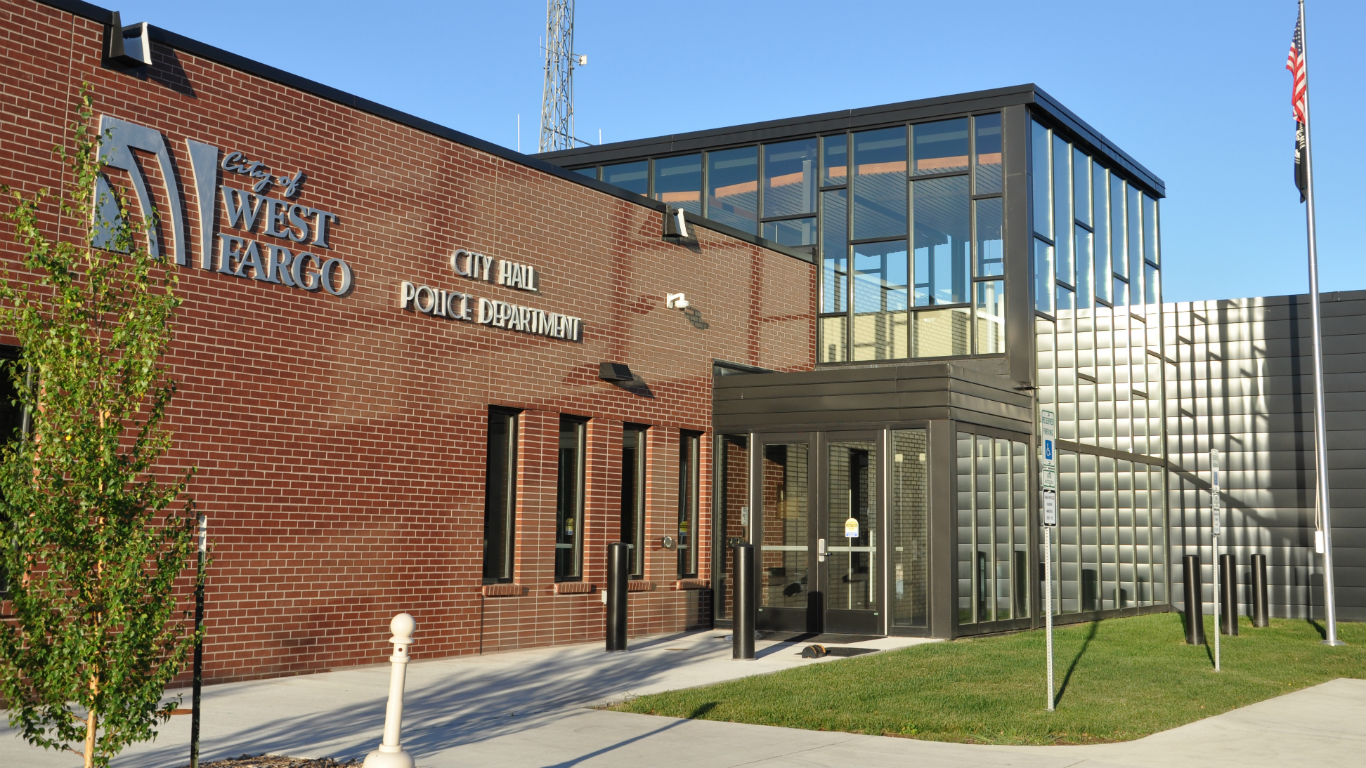
North Dakota: West Fargo
> Population: 34,419
> Median household income: $81,051
> Homeownership rate: 67.8%
> Avg. commute time: 16.6 minutes
> Metropolitan area: Fargo
In Fargo, North Dakota, the median household income is $53,309, nearly $7,000 lower than the national median. In West Fargo, however, the typical household earns over $81,000 per year. Fargo has a relatively low unemployment rate, at 3.5%, but West Fargo’s unemployment rate is less than half that, at 1.5%.
West Fargo has a much higher concentration of wealthy residents than can be found in Fargo, with 10.7% of households in the suburb earning $200,000 or more annually. In Fargo, just 5.2% of households have that level of income, and nationwide, 7.0% of American households do.
[in-text-ad-2]
Ohio: Pepper Pike
> Population: 6,242
> Median household income: $193,889
> Homeownership rate: 98.8%
> Avg. commute time: 22.1 minutes
> Metropolitan area: Cleveland
In Pepper Pike, just a few miles east of Cleveland, the median home value is $428,800. This is more than double the national median home value of just under $205,000 and more than six times the median home value in Cleveland of $68,500. Owning a home is one of the best ways to build wealth, as real estate tends to appreciate in value. Nearly 99% of Pepper Pike households own the home they live in, while Cleveland’s home ownership rate is 41.3%.
Cleveland is one of the most economically depressed cities in the nation, with most households earning less than $30,000. In Pepper Pike, the median household income is nearly $194,000. Cleveland’s 13.6% unemployment rate is more than double the U.S. unemployment rate of 5.9%, and several times Pepper Pike’s unemployment rate of just 2.0%.

Oklahoma: Piedmont
> Population: 7,424
> Median household income: $97,733
> Homeownership rate: 94.9%
> Avg. commute time: 29.2 minutes
> Metropolitan area: Oklahoma City
Piedmont, Oklahoma, situated northwest of Oklahoma City, has a median household income of $97,733, much higher than the national median of just over $60,000. Oklahoma City has a median household income of just over $54,000.
Though Oklahoma City has a relatively low unemployment rate — just 4.8% compared to the nationwide rate of 5.9% — Piedmont’s unemployment rate is much lower. In the town of just under 7,500 people, just 0.5% of the labor force is out of work, one of the lowest unemployment rates of anywhere in the U.S.
[in-text-ad]
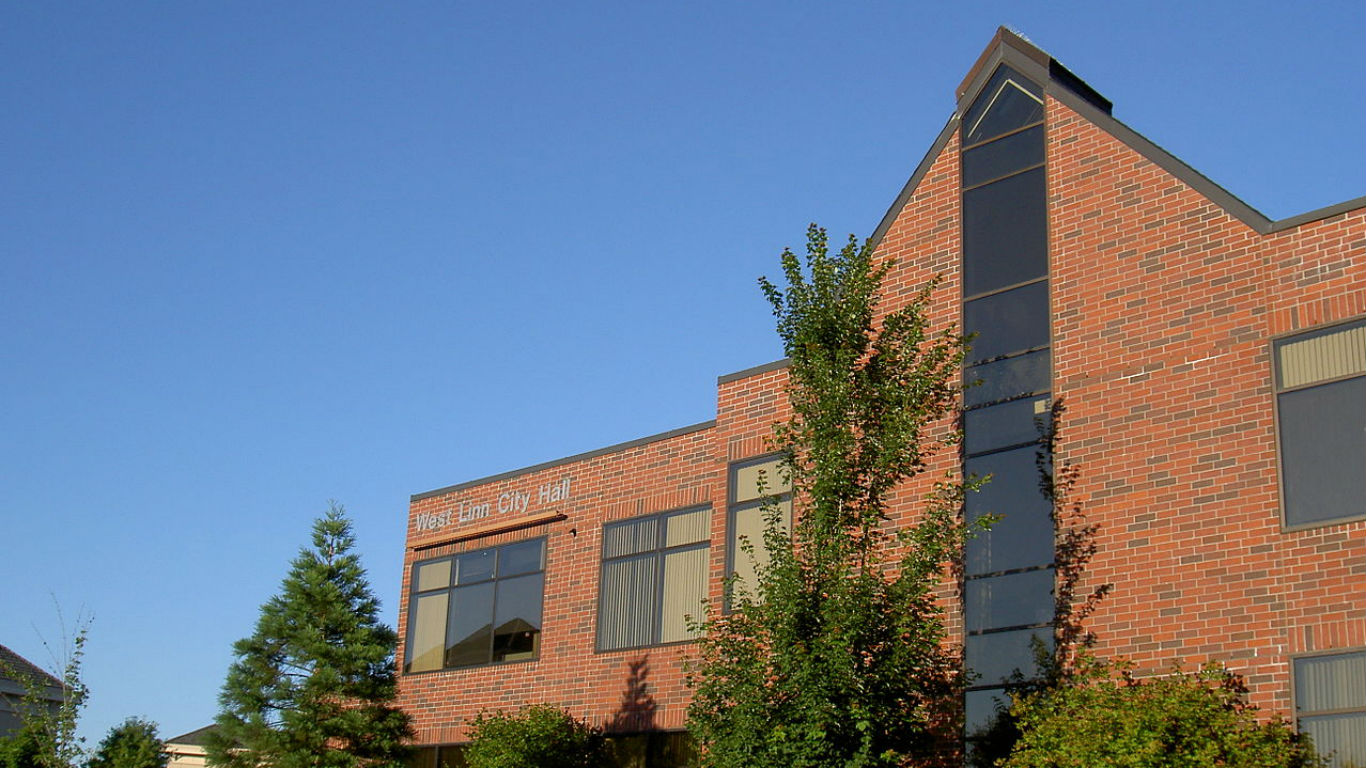
Oregon: West Linn
> Population: 26,511
> Median household income: $104,061
> Homeownership rate: 78.9%
> Avg. commute time: 28.3 minutes
> Metropolitan area: Portland
West Linn, Oregon, is less than 10 miles south of Portland, along the Willamette River. The poverty rate in Portland of 14.9% is slightly higher than the national poverty rate of 14.1%. Yet the poverty rate in West Linn is a fraction of that, at 5.0%. Though Portland’s median household income of $65,740 is more than $5,000 higher than the national median, it is far lower than the median income in its top suburb. Most houses in West Linn earn over $104,000 per year.
Portland has a relatively high violent crime rate, reporting 545 incidents of murder, rape, robbery, and aggravated assault per 100,000 residents in 2019. In West Linn, the violent crime was just a fraction of that, at 71 incidents per 100,000 residents that same year.

Pennsylvania: Swarthmore
> Population: 6,304
> Median household income: $109,648
> Homeownership rate: 77.8%
> Avg. commute time: 24 minutes
> Metropolitan area: Philadelphia
Swarthmore, which is a few miles west of Philadelphia, has a median home value of $410,100 — more than double the value of the typical homes in the U.S. and Philadelphia. Homes in Swarthmore tend to be relatively large, with a median of 7.4 rooms, compared to a median of 5.6 rooms in Philadelphia. Swarthmore’s median household income of nearly $110,000 is more than double Philadelphia’s median of $43,744.
Income and educational attainment are strongly linked, and Swarthmore residents have among the highest educational attainment in the country. The borough, which is home to Swarthmore College, has a 77.7% bachelor’s degree attainment rate, compared to a 28.6% rate in Philadelphia and a 31.5% rate nationwide.
Rhode Island: Tiverton
> Population: 7,757
> Median household income: $68,850
> Homeownership rate: 71.9%
> Avg. commute time: 25.7 minutes
> Metropolitan area: Providence
The best suburb in Rhode Island, Tiverton is a suburb of Providence, the only major metropolitan area in the state. It ranks as the best suburb in large part because of a low crime rate. While the violent crime rate in Providence is 496 incidents per 100,000 residents, the crime rate in Tiverton is less than 70 per 100,000.
Providence has a relatively high poverty rate — at 26% it is nearly double the 14.1% national poverty rate. Yet in Tiverton, just 6.8% of residents live in poverty. And while Tiverton’s unemployment rate of 5.9% is a full percentage point higher than the national unemployment rate, it is below Providence’s unemployment rate of 8.8%.
[in-text-ad-2]

South Carolina: Tega Cay
> Population: 9,954
> Median household income: $123,564
> Homeownership rate: 93.1%
> Avg. commute time: 32.1 minutes
> Metropolitan area: Charlotte
Tega Cay is located just south of South Carolina’s border with North Carolina. It ranks as the best suburb in the state in large part because residents are relatively affluent. The poverty rate in the core city, Charlotte, North Carolina, is roughly in line with the national rate of 14.1%. Yet Tega Cay’s poverty rate is just 0.7% — one of the lowest poverty rates of any city or suburb in the country.
Charlotte’s median household income of $60,886 is also similar to the national median, yet it is less than half of the median of over $123,500 in Tega Cay. More than one in five of area households earn over $200,000 annually.
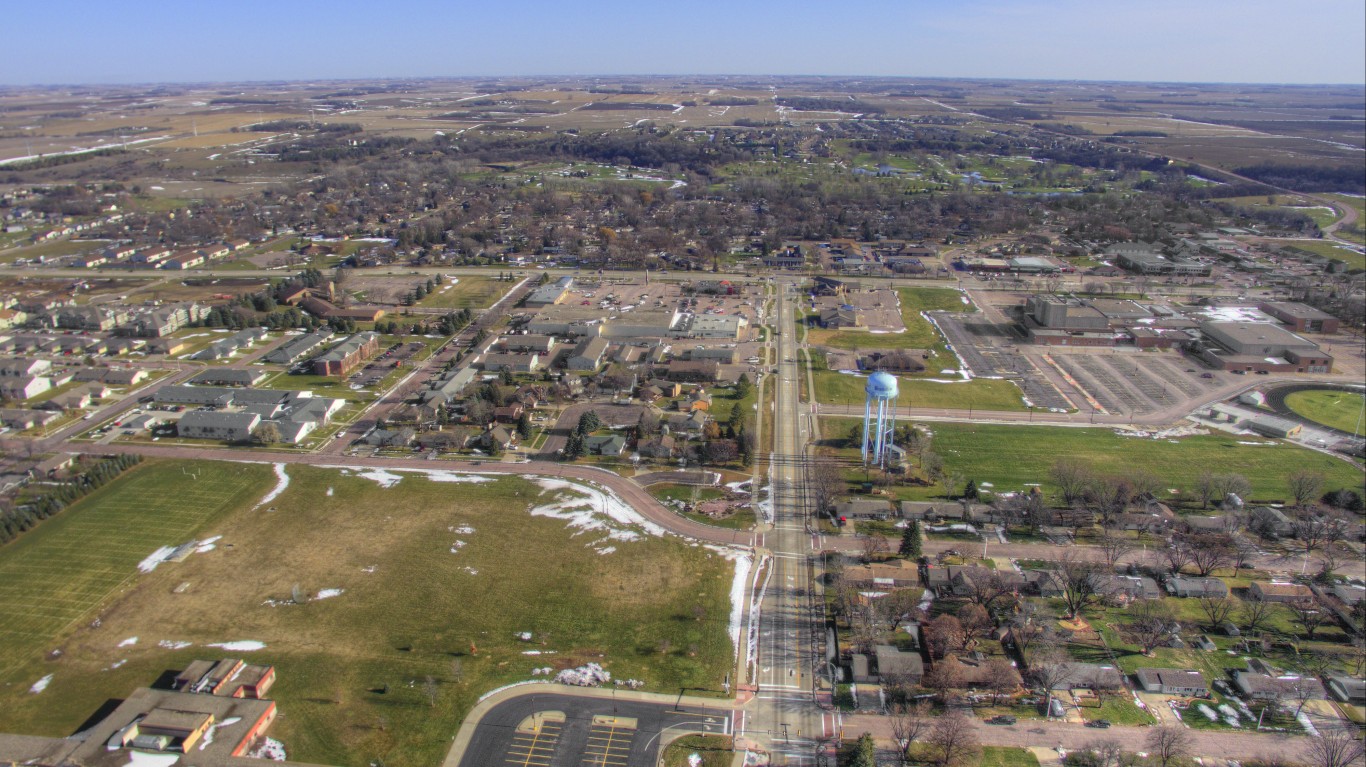
South Dakota: Brandon
> Population: 9,867
> Median household income: $84,075
> Homeownership rate: 73.3%
> Avg. commute time: 19.9 minutes
> Metropolitan area: Sioux Falls
Brandon, South Dakota’s proximity to Sioux Falls makes it an attractive suburb, as the average commute time is less than 20 minutes. Nationwide, the average commute is 26.6 minutes. Brandon’s median household income of over $84,000 is $25,000 higher than the median household income in Sioux Falls.
The Sioux Falls area has a strong job market, with just a 3.5% unemployment rate. The unemployment rate of Brandon is even lower, at 1.6%.
[in-text-ad]

Tennessee: Brentwood
> Population: 41,987
> Median household income: $160,597
> Homeownership rate: 90.8%
> Avg. commute time: 25.5 minutes
> Metropolitan area: Nashville-Davidson metropolitan government (balance)
Brentwood, which is just south of Nashville, ranks as the best suburb in Tennessee in large part because of its economic prosperity. Most area households earn over $160,000 a year — nearly triple the $55,873 median household income of Nashville.
Brentwood ranks as a top suburb in the state also because it is relatively safe. Nashville reported 1,073 violent crimes per 100,000 residents in 2019, nearly triple the national violent crime rate. In Brentwood, the violent crime rate was 88 incidents per 100,000 that same year.
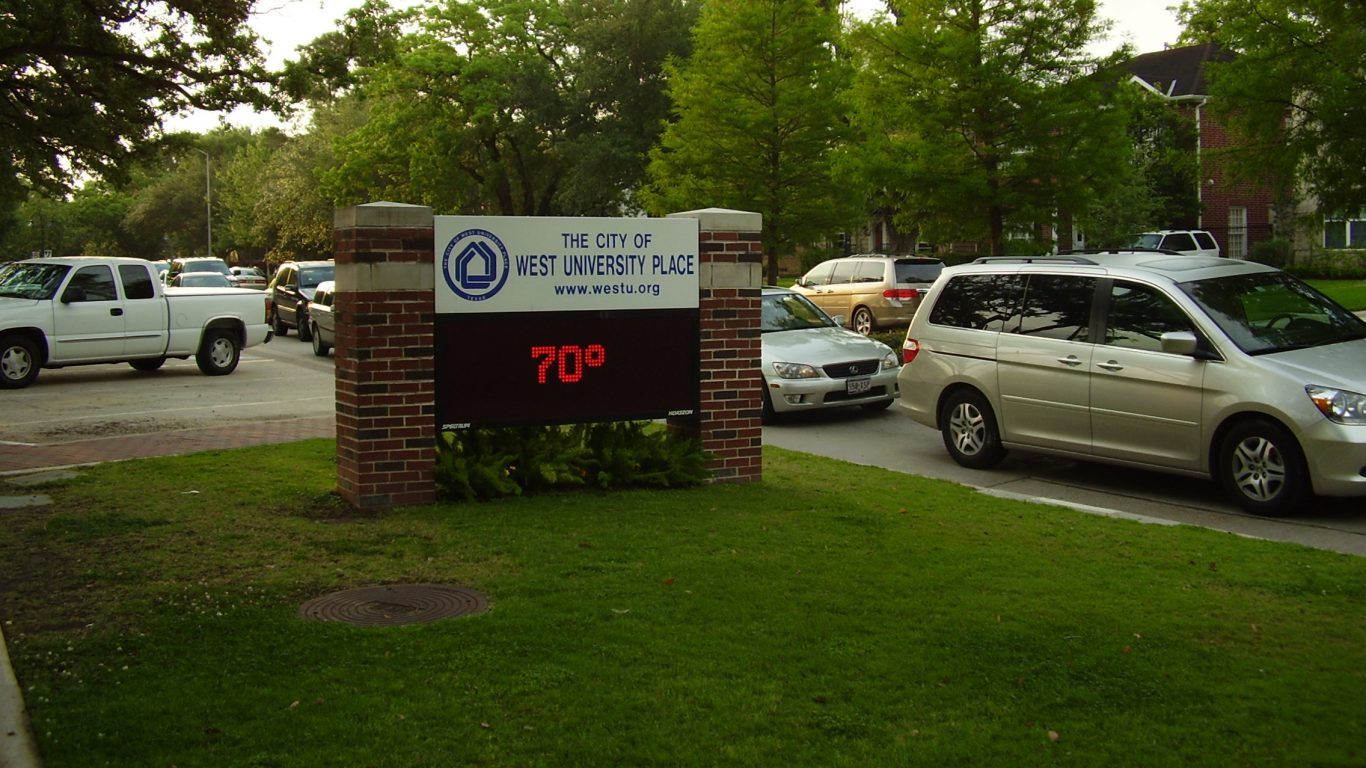
Texas: West University Place
> Population: 15,619
> Median household income: $250,000+
> Homeownership rate: 89.4%
> Avg. commute time: 20.7 minutes
> Metropolitan area: Houston
West University Place, located southwest of downtown Houston and just west of Rice University, ranks not just as the best suburb in Texas, but one of the 10 best in the country. Most households earn over $250,000 a year, and the typical home is worth over $1 million. In Houston, the median household income is just over $51,000 and the median home value is $161,300.
Houston has a relatively high 20.6% poverty rate, yet the poverty rate in West University Place is less than a 10th of that, at just 1.7%. As the name suggests, many residents of West University Place are college educated. The suburb has an 86.7% bachelor’s degree attainment rate, while Houston’s rate is just 32.1%.

Utah: Mapleton
> Population: 9,509
> Median household income: $109,356
> Homeownership rate: 94.3%
> Avg. commute time: 23.9 minutes
> Metropolitan area: Provo
The typical home in Mapleton, Utah, just outside of Provo, is worth about $390,000, well above the $247,100 median home value in Provo. Mapleton homes tend to be very large as most have nine or more rooms, while the median number of rooms in a Provo home is 5.1.
Mapleton has a median household income of over $109,000 — more than double the median in Provo of $46,532.
[in-text-ad-2]
Vermont: South Burlington
> Population: 18,975
> Median household income: $71,017
> Homeownership rate: 59.8%
> Avg. commute time: 16.4 minutes
> Metropolitan area: Burlington
Though they are directly next to one another, economic conditions in Burlington and South Burlington, Vermont are very different. In South Burlington, the median household income is $71,000 — more than $20,000 higher than in Burlington. Burlington has a relatively high poverty rate, at nearly 24%, while 6% of South Burlington residents live in poverty.
South Burlington is also safer than its northern neighbor. The violent crime rate in Burlington is 405 incidents of murder, rape, robbery, and aggravated assault per 100,000, slightly higher than the national rate of 367 per 100,000. In South Burlington, the violent crime rate is just 112 incidents per 100,000 residents.
Virginia: Vienna
> Population: 16,488
> Median household income: $155,490
> Homeownership rate: 84.1%
> Avg. commute time: 28.6 minutes
> Metropolitan area: Washington D.C.
Vienna, Virginia, is one of two Washington, D.C. suburbs to feature on this list. Washington, D.C. is a fairly affluent place, with a median household income of $82,604 — more than $20,000 higher than the national median. And Vienna’s median household income of $155,490 is nearly double Washington’s.
In spite of its high income level, the nation’s capital has a poverty rate of 14.3%, just slightly higher than the national poverty rate. Vienna’s poverty rate, however, is a fraction of that at just 2.4%.
[in-text-ad]

Washington: Sammamish
> Population: 64,049
> Median household income: $165,318
> Homeownership rate: 85.8%
> Avg. commute time: 33.2 minutes
> Metropolitan area: Seattle
The Seattle suburb of Sammamish ranks as the best suburb to live in Washington state. Residents there are among the most financially secure not only in the state, but the country. Just 2.2% live in poverty and 1.4% lack health insurance. In contrast, Seattle’s poverty rate is a relatively low 11.8%, and 4.6% lack health insurance.
Those with a college degree are more likely to earn higher incomes and have more stable jobs, and almost three-quarters of Sammamish’s adults have a bachelor’s degree, compared to 31.5% of the nation’s adults.
West Virginia: Charles Town
> Population: 5,885
> Median household income: $72,329
> Homeownership rate: 63.0%
> Avg. commute time: 38.9 minutes
> Metropolitan area: Washington D.C.
Charles Town, West Virginia, is located in the northeasternmost part of the state and is close enough to Washington, D.C. to be part of its metropolitan area. While it is nearly an hour and half drive from downtown D.C., it is still close enough to benefit economically from the major city. Charles Town has one of the highest median household incomes in the state, and with a median home value of $237,800, it is one of the only places in West Virginia with a median home value higher than that of the national figure of $204,900.

Wisconsin: Elm Grove
> Population: 6,172
> Median household income: $115,972
> Homeownership rate: 93.4%
> Avg. commute time: 23.2 minutes
> Metropolitan area: Milwaukee
The median home value in Elm Grove is $362,200, approximately three times the value of homes in the city of Milwaukee. The typical Elm Grove household has an income of nearly $116,000, nearly double the national median household income and much higher than Milwaukee’s $40,036 median household income. Just 3.5% of the village’s population lives in poverty, compared to 14.1% of Americans and 26.6% of Milwaukeeans.
[in-text-ad-2]
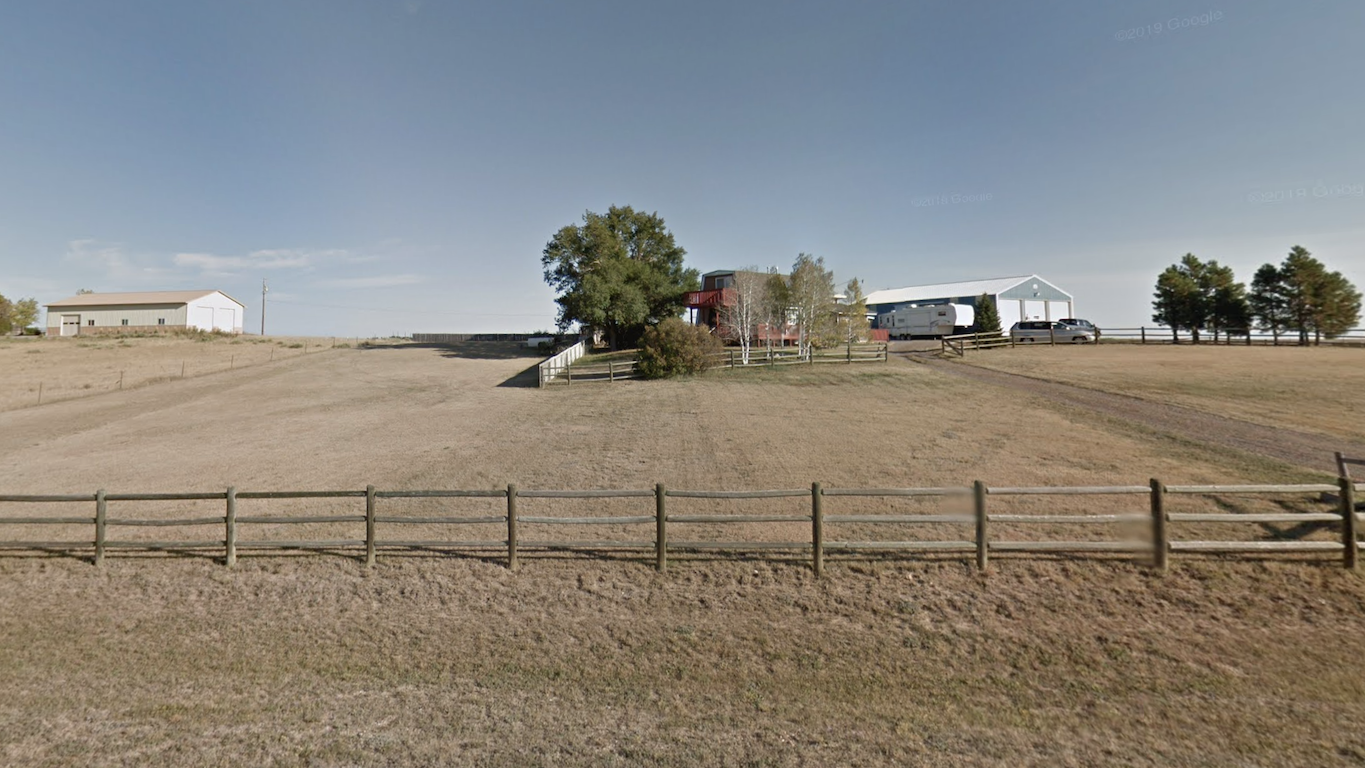
Wyoming: Ranchettes
> Population: 6,097
> Median household income: $95,250
> Homeownership rate: 91.3%
> Avg. commute time: 18.1 minutes
> Metropolitan area: Cheyenne
Ranchettes, Wyoming, is part of the Cheyenne metropolitan area and is located to the north of the state’s most populous city. It has a median household income of $95,250, which is about $35,000 higher than the national median household income.
Homeownership is often a sign of financial stability, and over 90% of households live in a home they own, one of the highest homeownership rates of any place in the state.
Methodology
To determine the best suburb in every state, 24/7 Wall St. constructed an index of 11 measures for suburbs within metropolitan statistical areas in the United States.
We considered as suburbs all cities, towns, villages, boroughs, and Census-designated places with populations of between 2,000 and 100,000 residents that fall within the boundaries of a metropolitan statistical area. MSAs are a Census-defined geography consisting of a core city and its adjacent communities, meant to approximate economic zones. The principal city of a metropolitan area was not considered a suburb.
Data on eight index measures came from the Census Bureau’s American Community Survey and are five-year estimates for 2014 to 2018: (1) median home value, (2) the median number of rooms in occupied housing units, (3) unemployment rate for the population 16 years and over, (4) the average travel time to work, (5) median household income, (6) homeownership rate, (7) poverty rate and (8) affordability ratio — the ratio of median home value to median household income.
Two other measures came from the FBI’s 2019 Uniform Crime Report: Data on (9) the number of violent crimes reported per 100,000 residents and (10) the number of property crimes reported per 100,000 residents came.
Data on the (11) percentage of the population with access to places for physical activity in the county where the suburb is located came from the 2020 County Health Rankings & Roadmaps, a joint program of the Robert Wood Johnson Foundation and the University of Wisconsin Population Health Institute. All 11 index measures were included at full weight.
To measure the quality-of-life advantages of living in the suburbs over living in the core city, each of these measures was also calculated as a percentage of its corresponding value in each suburb’s core city and included in the index at quarter weight.
Credit card companies are pulling out all the stops, with the issuers are offering insane travel rewards and perks.
We’re talking huge sign-up bonuses, points on every purchase, and benefits like lounge access, travel credits, and free hotel nights. For travelers, these rewards can add up to thousands of dollars in flights, upgrades, and luxury experiences every year.
It’s like getting paid to travel — and it’s available to qualified borrowers who know where to look.
We’ve rounded up some of the best travel credit cards on the market. Click here to see the list. Don’t miss these offers — they won’t be this good forever.
Thank you for reading! Have some feedback for us?
Contact the 24/7 Wall St. editorial team.